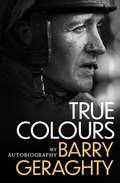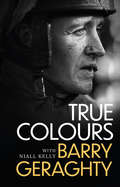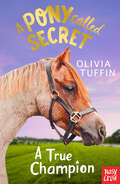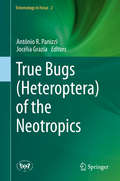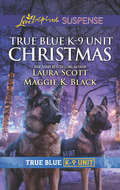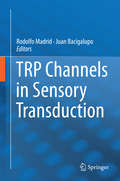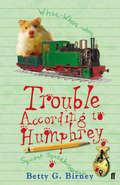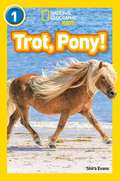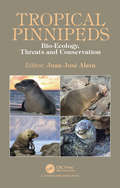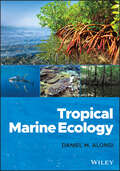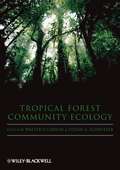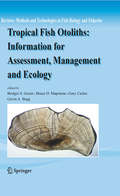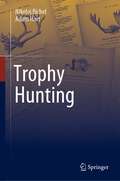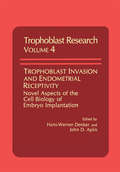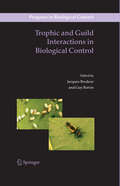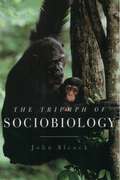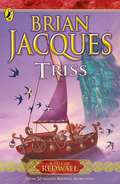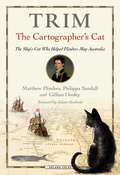- Table View
- List View
True Colours: My Autobiography
by Barry GeraghtyThe riveting full-career autobiography of Barry Geraghty, one of the most successful jump jockeys in the sport's history. Now retired, Geraghty takes his rightful place in the pantheon of greats that inclues AP McCoy, Richard Johnson and Ruby Walsh.Barry Geraghty is an Irish horseracing legend. From his first win in 1997 he has gone on to ride almost 2000 winners, making him the fourth most successful jumps jockey of all time. With the second most wins at Cheltenham in the sport's history, he has worked with all the greats - Moscow Flyer, Kicking King, Monty's Pass. Barry finally retired in July 2020, covered in scars. He has broken all of his limbs, his shoulders, his ribs, his nose. He has survived falls too numerous to recall, and spent most of 2019 with a metal cast on his leg. And yet, he kept getting back on the horse, for twenty-three years.His autobiography is about resilience, the mental power that enables the great to keep going despite the pain, despite the odds. It explores how Barry has developed the mind tools to continue to push himself, even when all seems lost. Containing startling revelations and a searingly honest insight into the life of a top jockey, this is a must-read for all sports fans.
True Colours
by Barry Geraghty Niall KellyBarry Geraghty is one of the greatest jockeys of all time.In 2003 he became famous the world over when he won the English Grand National aboard Monty’s Pass. In 2009 he became the first jockey to win the ‘big four’ races at Cheltenham Festival and the Grand National. In 2020 he won five races at Cheltenham Festival, including the Champion Hurdle, marking an astonishing comeback from a broken leg that saw him spend fourteen weeks of 2019 with his leg in a metal frame.Barry is covered in scars. He has broken all his limbs, his back on three occasions, his shoulders, his ribs and his nose, and acquired over 70 stitches to his face. He has survived falls too numerous to recall. And yet, he kept getting back on the horse.Brilliantly capturing the irreplaceable buzz and adrenaline of life as a jockey, True Colours charts Barry’s constant striving to find balance between chasing the highs and managing the lows in a notoriously high-stakes industry.It is a memoir about resilience, the mental power that enables the great to keep going despite the pain, despite the odds. It is about self-belief and how putting everything into something you’re passionate about can make dreams happen.
A True Champion (A Pony Called Secret)
by Olivia TuffinAlice and her beloved pony are off to train at Devon's world-class yard - following in the footsteps of the British Showjumping team!Alice and Secret have gone further than anyone thought possible . . . but on the day of the showjumping trials for the British team, Alice has to make an almost-impossible choice.Just how far is she prepared to go to reach the very top? What does the future hold for Alice and her spirited red pony?A perfect pony story from the author of the much-loved The Palamino Pony series.Have you read Alice and Secret's other adventures, 'A New Beginning','A Friend In Need','A Ride to Freedom','A Dream Come True'and'A Time To Shine'?
True Bugs (Entomology in Focus #2)
by Antônio R. Panizzi Jocélia GraziaTrue bugs (Heteroptera) are a diverse and complex group of plant-feeding and predatory insects important to food production, human health, the global economy and the environment. Within the nearly 43,000 species described around the world, Neotropical true bugs are particularly diverse, and much remains to be discovered about their biology and relations with other species. Inspired by the need for a comprehensive assessment, True Bugs (Heteroptera) of the Neotropics is the most complete and thorough review ever published.Experts in each of the seven infraorders have drawn together the scattered literature to provide detailed treatments of each major taxon. The most common and important species as well as select lesser known species in each major family are covered, highlighting morphology, classification, biology and ecology. The numerous color illustrations highlight key species and their adaptations, and importance to basic and applied sciences is discussed.Each chapter is based on an up-to-date review of the literature, and with a bibliography of more than 3,000 references, readers are presented with an unprecedented and vital and timely account of the true bugs of the Neotropical Region.
True Blue K-9 Unit Christmas: Holiday Emergency (true Blue K-9 Unit) / Crime Scene Christmas (true Blue K-9 Unit) (Mills And Boon Love Inspired Suspense Ser.)
by Laura Scott Maggie K. Black’Tis the season for danger…
TRP Channels in Sensory Transduction
by Rodolfo Madrid Juan BacigalupoTRP channels play a key role in sensory physiology and have been the focus of intensive investigation in recent years. The proposed book will be a comprehensive, detailed overview of the ways in which TRP channels are involved in a wide variety of sensory modalities. Authors will explore the involvement of TRP channels in photo transduction (sight), chemotransduction (taste and odor), mechanotransduction (touch and hearing), thermo transduction (the sensation of temperature) and pain perception. Furthermore, the book will include some grounding chapters such as one on the history of TRP channel research, one on the biophysical characteristics of the proteins and one on trafficking and post-translational regulation.
Trouble According to Humphrey (Humphrey the Hamster #3)
by Betty G. BirneyJoin Humphrey the hamster for his third adventure - and this one is going to be packed with trouble! When all sorts of problems crop up in the classroom, from Pay-Attention-Art's marks going down, to Golden-Miranda finding herself in big trouble, Humphrey must step in to lend a helping paw. Using his charm, resourcefulness and wisdom, he's certain to have a plan. This third instalment follows the brilliantly successful The World According to Humphrey and Friendship According to Humphrey.
Trot, Pony!: Level 1 (PDF)
by Shira Evans National Geographic Kids StaffNational Geographic Primary Readers is a high-interest series of beginning reading books that have been developed in consultation with education experts. The books pair magnificent National Geographic photographs with lively text by skilled children’s book authors across four reading levels. From Welsh mountain ponies to Shetland ponies, young readers will learn all about these beautiful animals in this Level 1 books. Told in simple yet lively text, Trot, Pony! will enchant kids who are just beginning their reading journey. Level 1: Early reader: These books contain simple sentences and are just right for kids who can decode with ease and are beginning to read fluently. They are ideal for readers of Yellow and Blue banded books.
Tropical Pinnipeds: Bio-Ecology, Threats and Conservation
by Juan J. AlavaPinnipeds are a fascinating group of marine mammals that play a crucial role as apex predators and sentinels of the functioning and health of marine ecosystems. They are found in the most extreme environments from the Polar regions to the tropics. Pinnipeds are comprised of about 34 species, and of those at least 25% live permanently in tropical zones. This book reviews and updates current research on the biology, marine ecology, bio-monitoring, and conservation of tropical pinniped populations, including their behavior, anthropogenic stressors, and health. It also looks at challenges to be faced for the conservation of tropical pinnipeds, many of which are threatened species.
Tropical Pinnipeds: Bio-Ecology, Threats and Conservation
by Juan José AlavaPinnipeds are a fascinating group of marine mammals that play a crucial role as apex predators and sentinels of the functioning and health of marine ecosystems. They are found in the most extreme environments from the Polar regions to the tropics. Pinnipeds are comprised of about 34 species, and of those at least 25% live permanently in tropical zones. This book reviews and updates current research on the biology, marine ecology, bio-monitoring, and conservation of tropical pinniped populations, including their behavior, anthropogenic stressors, and health. It also looks at challenges to be faced for the conservation of tropical pinnipeds, many of which are threatened species.
Tropical Marine Ecology
by Daniel M. AlongiNo realm on Earth elicits thoughts of paradise more than the tropics. The tropical marine realm is special in myriad ways and for many reasons from seas of higher latitude, in housing iconic habitats such as coral reefs, snow white beaches, crystal clear waters, mangrove forests, extensive and rich seagrass meadows and expansive river deltas, such as the exemplar, the Amazon. But the tropics also has an even more complex side: tropical waters give rise to cyclones, hurricanes and typhoons, and unique oceanographic phenomena including the El Niño- Southern Oscillation which affects global climate patterns. Tropical Marine Ecology documents the structure and function of tropical marine populations, communities, and ecosystems in relation to environmental factors including climate patterns and climate change, and patterns of oceanographic phenomena such as tides and currents and major oceanographic features, as well as chemical and geological drivers. The book focuses on estuarine, coastal, continental shelf and open ocean ecosystems. The first part of the book deals with the climate, physics, geology, and chemistry of the tropical marine environment. The second section focuses on the origins, diversity, biogeography, and the structure and distribution of tropical biota. The third part explores the rates and patterns of primary and secondary production, and their drivers, and the characteristics of pelagic and benthic food webs. The fourth part examines how humans are altering tropical ecosystems via unsustainable fisheries, the decline and loss of habitat and fragmentation, Further, pollution is altering an earth already in the throes of climate change. Tropical Marine Ecology is an authoritative and comprehensive introduction to tropical marine ecology for advanced undergraduate and postgraduate students. It is also a rich resource and reference work for researchers and professional managers in marine science.
Tropical Marine Ecology
by Daniel M. AlongiNo realm on Earth elicits thoughts of paradise more than the tropics. The tropical marine realm is special in myriad ways and for many reasons from seas of higher latitude, in housing iconic habitats such as coral reefs, snow white beaches, crystal clear waters, mangrove forests, extensive and rich seagrass meadows and expansive river deltas, such as the exemplar, the Amazon. But the tropics also has an even more complex side: tropical waters give rise to cyclones, hurricanes and typhoons, and unique oceanographic phenomena including the El Niño- Southern Oscillation which affects global climate patterns. Tropical Marine Ecology documents the structure and function of tropical marine populations, communities, and ecosystems in relation to environmental factors including climate patterns and climate change, and patterns of oceanographic phenomena such as tides and currents and major oceanographic features, as well as chemical and geological drivers. The book focuses on estuarine, coastal, continental shelf and open ocean ecosystems. The first part of the book deals with the climate, physics, geology, and chemistry of the tropical marine environment. The second section focuses on the origins, diversity, biogeography, and the structure and distribution of tropical biota. The third part explores the rates and patterns of primary and secondary production, and their drivers, and the characteristics of pelagic and benthic food webs. The fourth part examines how humans are altering tropical ecosystems via unsustainable fisheries, the decline and loss of habitat and fragmentation, Further, pollution is altering an earth already in the throes of climate change. Tropical Marine Ecology is an authoritative and comprehensive introduction to tropical marine ecology for advanced undergraduate and postgraduate students. It is also a rich resource and reference work for researchers and professional managers in marine science.
Tropical Forest Community Ecology
by Walter P. Carson Stefan A. SchnitzerHistorically, tropical ecology has been a science often content with descriptive and demographic approaches, which is understandable given the difficulty of studying these ecosystems and the need for basic demographic information. Nonetheless, over the last several years, tropical ecologists have begun to test more sophisticated ecological theory and are now beginning to address a broad array of questions that are of particular importance to tropical systems, and ecology in general. Why are there are so many species in tropical forests and what mechanisms are responsible for the maintenance of that vast species diversity? What factors control species coexistence? Are there common patterns of species abundance and distribution across broad geographic scales? What is the role of trophic interactions in these complex ecosystems? How can these fragile ecosystems be conserved? Containing contributions from some of the world’s leading tropical ecologists, Tropical Forest Community Ecology provides a summary of the key issues in the discipline of tropical ecology: Includes contributions from some of the world’s leading tropical ecologists Covers patterns of species distribution, the maintenance of species diversity, the community ecology of tropical animals, forest regeneration and conservation of tropical ecosystems
Tropical Forest Community Ecology
by Walter Carson Stefan SchnitzerHistorically, tropical ecology has been a science often content with descriptive and demographic approaches, which is understandable given the difficulty of studying these ecosystems and the need for basic demographic information. Nonetheless, over the last several years, tropical ecologists have begun to test more sophisticated ecological theory and are now beginning to address a broad array of questions that are of particular importance to tropical systems, and ecology in general. Why are there are so many species in tropical forests and what mechanisms are responsible for the maintenance of that vast species diversity? What factors control species coexistence? Are there common patterns of species abundance and distribution across broad geographic scales? What is the role of trophic interactions in these complex ecosystems? How can these fragile ecosystems be conserved? Containing contributions from some of the world’s leading tropical ecologists, Tropical Forest Community Ecology provides a summary of the key issues in the discipline of tropical ecology: Includes contributions from some of the world’s leading tropical ecologists Covers patterns of species distribution, the maintenance of species diversity, the community ecology of tropical animals, forest regeneration and conservation of tropical ecosystems
Tropical Fish (UEB uncontracted)
by RnibThis image shows two fish seen from the side with their heads on the right of the page and their tails on the left of the page. There is a locator dot shown, which will be at the top left of the page when the image is the correct way up. The fish at the top of the page is a common clown-fish. On the right of the image its mouth is slightly open. Up and left one of its two eyes is shown. To the left of the fish's head is a vertical curved band of white edged with black. Left of this is one of the two rounded pectoral fins. It is coloured yellow-orange like most of the fish and has a black border edge to the top and left. The middle of the fish has another vertical forward pointing band of white edged with black. In the bottom centre of the fish is one of the two pelvic fins. In the bottom left of the fish is the single, central anal fin. These fins are also coloured yellow-orange and have a black border edge to the bottom and left. On the left of the image is the rounded tail or caudal fin. It is coloured a darker yellow-orange and has a black border edge to the left. To the right of the tail is another vertical band of white edged with black. Up and right from this is one part of the dorsal fin. It is coloured a darker yellow-orange and has a black border edge to the top and left. In the top centre of the fish is the first part of the dorsal fin. It is a darker orange colour and gets darker towards the edge. There is no distinct black border. The fish at the bottom of the page is an angelfish. In the centre of its head on the right one of its two eyes is shown. It has a larger eye orbit which is coloured bright orange. The fish is white with black vertical stripes. One of these black stripes goes across the orbit in line with the black eye iris. Down and left from the eye is an irregularly shaped gill cover. Left from the gill cover is one of the two pectoral fins with a scalloped edge. A black vertical stripe goes behind this fin. Down from this is one of the two pelvic fins, it is long, thin and curves down and left to a point. It is coloured white. To the left of the pectoral fin is another black vertical stripe. It continues onto the large pointed anal fin in the bottom left of the image as a dark grey stripe. It continues onto the large triangular dorsal fin at the top of the fish, again as a dark grey colour. The black band behind the pectoral fin also continues onto the dorsal fin briefly. There is a small black vertical stripe on the left where the tail joins the body. The tail or caudal fin is broad and white. It has a spike going left from the bottom edge.
Tropical Fish (UEB contracted)
by RnibThis image shows two fish seen from the side with their heads on the right of the page and their tails on the left of the page. There is a locator dot shown, which will be at the top left of the page when the image is the correct way up. The fish at the top of the page is a common clown-fish. On the right of the image its mouth is slightly open. Up and left one of its two eyes is shown. To the left of the fish's head is a vertical curved band of white edged with black. Left of this is one of the two rounded pectoral fins. It is coloured yellow-orange like most of the fish and has a black border edge to the top and left. The middle of the fish has another vertical forward pointing band of white edged with black. In the bottom centre of the fish is one of the two pelvic fins. In the bottom left of the fish is the single, central anal fin. These fins are also coloured yellow-orange and have a black border edge to the bottom and left. On the left of the image is the rounded tail or caudal fin. It is coloured a darker yellow-orange and has a black border edge to the left. To the right of the tail is another vertical band of white edged with black. Up and right from this is one part of the dorsal fin. It is coloured a darker yellow-orange and has a black border edge to the top and left. In the top centre of the fish is the first part of the dorsal fin. It is a darker orange colour and gets darker towards the edge. There is no distinct black border. The fish at the bottom of the page is an angelfish. In the centre of its head on the right one of its two eyes is shown. It has a larger eye orbit which is coloured bright orange. The fish is white with black vertical stripes. One of these black stripes goes across the orbit in line with the black eye iris. Down and left from the eye is an irregularly shaped gill cover. Left from the gill cover is one of the two pectoral fins with a scalloped edge. A black vertical stripe goes behind this fin. Down from this is one of the two pelvic fins, it is long, thin and curves down and left to a point. It is coloured white. To the left of the pectoral fin is another black vertical stripe. It continues onto the large pointed anal fin in the bottom left of the image as a dark grey stripe. It continues onto the large triangular dorsal fin at the top of the fish, again as a dark grey colour. The black band behind the pectoral fin also continues onto the dorsal fin briefly. There is a small black vertical stripe on the left where the tail joins the body. The tail or caudal fin is broad and white. It has a spike going left from the bottom edge.
Tropical Fish Otoliths: Information for Assessment, Management and Ecology (Reviews: Methods and Technologies in Fish Biology and Fisheries #11)
by Bridget S. Green Gavin A. Begg Gary Carlos Bruce D. MapstoneTechniques and theory for processing otoliths from tropical marine fish have developed only recently due to an historic misconception that these organisms could not be aged. Otoliths are the most commonly used structures from which daily, seasonal or annual records of a fish’s environmental history are inferred, and are also used as indicators of migration patterns, home range, spatial distribution, stock structure and life history events. A large proportion of projects undertaken on tropical marine organisms involve removal and processing of calcified structures such as otoliths, statoliths or vertebrae to retrieve biological, biochemical or genetic information. Current techniques and principles have evolved rapidly and are under constant modification and these differ among laboratories, and more particularly among species and within life history stages. Tropical fish otoliths: Information for assessment, management and ecology is a comprehensive description of the current status of knowledge about otoliths in the tropics. This book has contributions from leading experts in the field, encompassing a tropical perspective on daily and annual ageing in fish and invertebrates, microchemistry, interpreting otolith microstructure and using it to back-calculate life history events, and includes a treatise on the significance of validating periodicity in otoliths.
Tropical Fish (large print)
by RnibThis image shows two fish seen from the side with their heads on the right of the page and their tails on the left of the page. There is a locator dot shown, which will be at the top left of the page when the image is the correct way up. The fish at the top of the page is a common clown-fish. On the right of the image its mouth is slightly open. Up and left one of its two eyes is shown. To the left of the fish's head is a vertical curved band of white edged with black. Left of this is one of the two rounded pectoral fins. It is coloured yellow-orange like most of the fish and has a black border edge to the top and left. The middle of the fish has another vertical forward pointing band of white edged with black. In the bottom centre of the fish is one of the two pelvic fins. In the bottom left of the fish is the single, central anal fin. These fins are also coloured yellow-orange and have a black border edge to the bottom and left. On the left of the image is the rounded tail or caudal fin. It is coloured a darker yellow-orange and has a black border edge to the left. To the right of the tail is another vertical band of white edged with black. Up and right from this is one part of the dorsal fin. It is coloured a darker yellow-orange and has a black border edge to the top and left. In the top centre of the fish is the first part of the dorsal fin. It is a darker orange colour and gets darker towards the edge. There is no distinct black border. The fish at the bottom of the page is an angelfish. In the centre of its head on the right one of its two eyes is shown. It has a larger eye orbit which is coloured bright orange. The fish is white with black vertical stripes. One of these black stripes goes across the orbit in line with the black eye iris. Down and left from the eye is an irregularly shaped gill cover. Left from the gill cover is one of the two pectoral fins with a scalloped edge. A black vertical stripe goes behind this fin. Down from this is one of the two pelvic fins, it is long, thin and curves down and left to a point. It is coloured white. To the left of the pectoral fin is another black vertical stripe. It continues onto the large pointed anal fin in the bottom left of the image as a dark grey stripe. It continues onto the large triangular dorsal fin at the top of the fish, again as a dark grey colour. The black band behind the pectoral fin also continues onto the dorsal fin briefly. There is a small black vertical stripe on the left where the tail joins the body. The tail or caudal fin is broad and white. It has a spike going left from the bottom edge.
Trophy Hunting
by Nikolaj Bichel Adam HartThis book gets to the heart of trophy hunting, unpacking and explaining its multiple facets and controversies, and exploring why it divides environmentalists, the hunting community, and the public. Bichel and Hart provide the first interdisciplinary and comprehensive approach to the study of trophy hunting, investigating the history of trophy hunting, and delving into the background, identity and motivation of trophy hunters. They also explore the role of social media and anthropomorphism in shaping trophy hunting discourse, as well as the viability of trophy hunting as a wildlife management tool, the ideals of fair chase and sportsmanship, and what hunting trophies are, both literally and in terms of their symbolic value to hunters and non-hunters. The analyses and discussions are underpinned by a consideration of the complex moral and practical conflicts between animal rights and conservation paradigms. This book appeals to scholars in environmental philosophy, conservation and environmental studies, as well as hunters, hunting opponents, wildlife management practitioners, and policymakers, and anyone with a broad interest in human–wildlife relations.
Trophoblast Invasion and Endometrial Receptivity: Novel Aspects of the Cell Biology of Embryo Implantation (Trophoblast Research #4)
by John D. Aplin Hans-Werner DenkerInterest in mechanisms of embryo implantation is increasing, particularly with the realization that failure of implantation after in vitro fertilization and embryo transfer places significant limits on the success of treatment. In addition, there is a need to provide hypotheses, and ultimately mechanisms, for the high rates of embryonic loss in women in the population at large. Traditionally, implantation research has concentrated on genetics and endocrinology without providing many therapeutic benefits. A new era is now beginning with the application of modem cellular and molecular approaches to the investigation of the relationship between trophoblast and endometrium. At the same time, older data can be reevaluated in the light of current research into cell cell and cell-matrix interactions. The feeling that new avenues of research are open was apparent when an international group of scientists came together at a workshop on "The Cell Biology of Trophoblast Invasion In Vivo and In Vitro" held during the XXIV Annual Meeting of the Cell, Tissue and Organ Culture Study Group (C.T.O.C.) at Heidelberg in 1986. What was unusual about this Conference was the interdisciplinary dialogue between implantation researchers and tumor biologists, highlighting aspects common to invasion of trophoblast and tumor cells.
Trophic and Guild Interactions in Biological Control (Progress in Biological Control #3)
by Jacques Brodeur Guy BoivinThis volume explores modern concepts of trophic and guild interactions among natural enemies in natural and agricultural ecosystems - a field that has become a hot topic in ecology and biological control over the past decade. It is the first book on trophic and guild interactions to make the link to biological control, and is compiled by internationally recognized scientists who have combined their expertise.
The Triumph of Sociobiology
by John AlcockIn The Triumph of Sociobiology, John Alcock reviews the controversy that has surrounded evolutionary studies of human social behavior following the 1975 publication of E.O. Wilson's classic, Sociobiology, The New Synthesis. Denounced vehemently as an "ideology" that has justified social evils and inequalities, sociobiology has survived the assault. Twenty-five years after the field was named by Wilson, the approach he championed has successfully demonstrated its value in the study of animal behavior, including the behavior of our own species. Yet, misconceptions remain--to our disadvantage. In this straight-forward, objective approach to the sociobiology debate, noted animal behaviorist John Alcock illuminates how sociobiologists study behavior in all species. He confronts the chief scientific and ideological objections head on, with a compelling analysis of case histories that involve such topics as sexual jealousy, beauty, gender difference, parent-offspring relations, and rape. In so doing, he shows that sociobiology provides the most satisfactory scientific analysis of social behavior available today. Alcock challenges the notion that sociobiology depends on genetic determinism while showing the shortcoming of competing approaches that rely on cultural or environmental determinism. He also presents the practical applications of sociobiology and the progress sociobiological research has made in the search for a more complete understanding of human activities. His reminder that "natural" behavior is not "moral" behavior should quiet opponents fearing misapplication of evolutionary theory to our species. The key misconceptions about this evolutionary field are dissected one by one as the author shows why sociobiologists have had so much success in explaining the puzzling and fascinating social behavior of nonhuman animals and humans alike.
The Triumph of Henry Cecil: The Authorised Biography
by Tony Rushmer'A wonderfully insightful, detailed and emotional biography of the legendary trainer's later years' Racing Post'[Cecil's] is a remarkable story and it has now been told with compassion, love, honesty and wonderful insight by Tony Rushmer' David Walsh, Sunday TimesWith a foreword by John GosdenWhen Henry Cecil sent out just 12 winners in 2005 it seemed as if the 10-time champion racehorse trainer's career was in terminal decline. The masterly touch that he'd shown through the glory-days of the two previous decades appeared to have deserted him after a series of painful professional and personal blows, including the death of his twin brother David. When Cecil was diagnosed with cancer in June 2006, it would have been enough to break many a man. But behind the scenes, the master of Warren Place in Newmarket was determined not to be labelled - in his words - a 'has-been'. Showing an iron resolve to fight for his professional reputation as well as his life, Cecil staged one of the great sporting comebacks. It was a story that captured the imagination of the racing public and beyond, peaking with his supreme handling of the unbeaten champion Frankel. Cecil's astonishing revival was witnessed in close-up by Tony Rushmer. The sports journalist became a trusted stable insider after being engaged in spring 2006 to help with the trainer's website and PR. He would remain part of the team right up until Cecil died in June 2013. Rushmer's unique access over seven years - in which he saw Cecil at the best and worst of times - allows him to provide a fresh perspective on an incredible part of the trainer's career. He is helped by many of those who were closest to the story, having interviewed numerous people during his extensive research. Containing fascinating detail and a wealth of new material, The Triumph of Henry Cecil shows how Cecil emerged from his slump, displayed relentless strength in the face of a cruel disease and trained the magnificent Frankel - as brilliant a racehorse as the sport has ever known.
Triss (Redwall)
by Brian JacquesThe fifteenth book in the beloved, bestselling Redwall saga - soon to be a major Netflix movie!Triss is a brave squirrelmaid - enslaved by the evil ferret King Agarnu of Riftgard and his cruel daughter, Kurna. But, secretly, Triss is planning a daring escape by sea . . .As Triss sets sail, three young friends leave Salamandastron in search of adventure - and two youngsters go missing in Mossflower Woods. After three dangerous journeys, the travellers' paths cross at the famous Redwall Abbey - where Triss will discover her destiny, and a new champion will rise to carry the legendary sword of Martin the Warrior and fight for the future of Redwall . . .
Trim, The Cartographer's Cat: The ship's cat who helped Flinders map Australia
by Matthew Flinders Gillian Dooley Philippa SandallNot many ships' cats have even one memorial statue, let alone six. But Trim does, including one outside Euston Station in London, proudly unveiled by Prince William on the bicentenary of Matthew Flinders's death – 19 July 2014. Trim was the ship's cat who accompanied Matthew Flinders on his voyages to circumnavigate and map the coastline of Australia from 1801 to 1803. He lived quite the adventurous life. As a small kitten he fell overboard while at sea but managed to swim back to the vessel and climb back on board by scaling a rope. This cemented his position as Flinders's beloved companion, and together they survived a Pacific voyage, the circumnavigation of Australia and a shipwreck. When Flinders was imprisoned by the French in Mauritius in 1803 Trim shared his captivity until one day he mysteriously disappeared – which heartbreakingly Flinders attributed to his being stolen and eaten by a hungry slave.Trim, The Cartographer's Cat is an ode to this much-loved ship's cat, which will warm the heart of any cat lover. The first part of the book reproduces Flinders' own whimsical tribute to Trim, written while in captivity in the early 1800s, with added 'friendly footnotes' to provide some background to Flinders's numerous literary allusions and nautical terms. Next the book discusses where Flinders was when he wrote his tribute and why, and what his letters and journals from that time tell us about his 'sporting, affectionate and useful companion'. Finally, we learn what Trim's views on all of this might have been, in a fun and fanciful observation on his premature epitaph. Accompanying all of this are beautiful maps, historical photographs, quirky original illustrations by illustrator Ad Long and excerpts from Flinders' original script, showing his beautiful handwriting. This book will make a unique and treasured gift for Flinders fans, Trim fans and cat lovers around the world.
